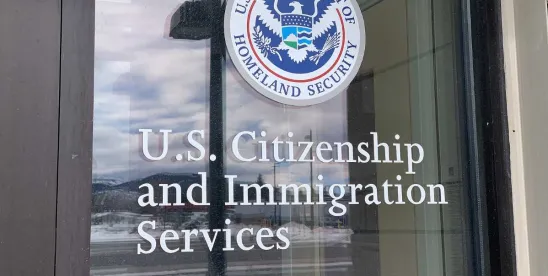On July 16, 2024, U.S. Citizenship and Immigration Services (USCIS) issued new guidance for the EB-5 Regional Center Program, detailing sanctions for noncompliance, adverse actions on EB-5 petitions, and special rules for good faith investors to maintain eligibility if their regional center or project is terminated or debarred.
On March 15, 2022, President Biden signed the EB-5 Reform and Integrity Act (RIA) into law, substantially reforming the EB-5 program. The RIA also added significant new integrity provisions, including protection for good faith investors. Now, more than two years after its passage, USCIS has updated its policy manual to include guidance addressing new provisions the RIA added to the Immigration and Nationality Act (INA), clarifying the consequences of noncompliance for regional centers, new commercial enterprises (NCEs), job creating entities (JCEs), and EB-5 investors. The new provisions update Part G, Investors, in Volume 6 of the policy manual to add provisions relating to “good faith investors” and add new authority for USCIS to sanction regional centers, new commercial enterprises, and job-creating entities at various levels for noncompliance with statutory requirements.
In particular, the new guidance clarifies the impact of USCIS terminating, debarring, or suspending noncompliant regional centers, NCEs, and JCEs, and it explains how good faith investors, including those who filed petitions prior to the RIA, may remain eligible for approval of the I-526 or I-829 petition in these scenarios. The guidance also sets forth factors and processes USCIS uses to assess sanctions and explains what constitutes fraud and material misrepresentation, deceit, criminal misuse, and threats to the national interest. The guidance further clarifies that USCIS does not sanction individuals or entities for pre-RIA actions but may still consider violations that occurred pre-RIA in determining proper sanctions for post-RIA violations.
In its Policy Manual Volume 6, Part G, Chapter 3, Section E, titled “Good Faith Investors Following Program Noncompliance by a Regional Center, New Commercial Enterprise, or Job-Creating Entity,” USCIS clarifies the actions USCIS will take if an EB-5 entity is no longer allowed to participate in the EB-5 program, such as after a regional center is terminated or an NCE or JCE is debarred. The guidance clarifies that USCIS debars individuals or entities based on noncompliance with or prohibited conduct under the RIA and does not debar individuals or entities for merely failing to establish investor eligibility for visa classification or removal of conditions, such as not creating sufficient employment, or upon receipt of requests for debarment. This means that investors cannot request a debarment to trigger the “good faith” investor protections simply where job creation is not met or where the project has failed under normal business scenarios.
Pre-RIA Investors
Consistent with its prior guidance, USCIS confirms that if a regional center is terminated, investors who filed I-526 petitions before the RIA’s March 2022 enactment can have an I-526 petition or I-829 petition approved even if the regional center’s designation is terminated, assuming the investor otherwise meets the eligibility requirements, including sustaining the at-risk investment and creating at least 10 jobs. USCIS again confirms that direct and indirect job creation can be used to meet the requirements, even when the regional center is terminated. The policy manual explains that USCIS officers will have the discretion to make a good faith determination on a case-by-case basis to continue to approve petitions.
Where a pre-RIA investor has invested into an NCE and/or a JCE that is debarred from the EB-5 program, USCIS clarifies that the investor may seek to retain eligibility by making an investment in another new commercial enterprise. In the policy manual update, USCIS states that if a pre-RIA investor chooses to make a qualifying investment in another NCE following regional center termination, the investment amount required is the amount required by statute at the time the investor initially filed the Form I-526. As of the date of this blog, it is not clear if any “good faith” pre-RIA investors have successfully filed a new I-526 petition on this basis, or made a new $500,000 investment into a new NCE to continue to qualify for permanent residence after a regional center is terminated or after an NCE or JCE debarment, even though the required investment amount has increased under the RIA. Further engagement and clarification are required by USCIS on this point.
RIA Investors
The policy manual update confirms that when USCIS terminates a regional center that is sponsoring RIA investors who filed Form I-526E after March 2022, the investor’s NCE may associate with a new regional center that is maintaining its designation in order to continue to qualify for permanent residence. That new regional center need not cover the geographic area of the EB-5 project. EB-5 stakeholders have been seeking this change for years, believing that a change of a regional center should not be considered a “material change” to the investor’s petition.
If an NCE or JCE is debarred for an RIA investor, the investor may retain eligibility if they associate with an NCE in good standing and, pursuant to the RIA, invest additional capital “solely to the extent necessary to satisfy remaining job creation requirements.” Practically, it may be difficult for new EB-5 projects to take additional capital from these “good faith” investors where new NCEs are seeking to subscribe investors at the new investment amounts of $1,050,000 or $800,000 but where the good faith investor seeks to invest some lesser amount only to continue to qualify for the green card. Projects should consider if they wish to create different classes of investments for varying investment amounts to accommodate these types of investors.
Additionally, USCIS states that the investor must generally file an amendment to their petition or otherwise notify USCIS that they continue to meet applicable eligibility requirements notwithstanding termination or debarment, as applicable, no later than 180 days after notification of termination or debarment. Filing an amendment to an I-526E would be costly to an investor following the April 2024 filing fee increases, but USCIS may accept additional evidence in response to a debarment notification that would not require the investor to file an amendment or pay the fee. Until USCIS promulgates a new Form I-526E, the exact procedures to be followed in this scenario remain unclear.
Terminations, Suspensions, and Sanctions
USCIS also updated Volume 6, Part G, Chapter 4, Section H, “Terminations, Suspensions, and Other Sanctions,” which specifies violations permitting various sanctions for bad faith actions by regional centers, ranging from fines to suspension or termination in more serious cases. This update exemplifies USCIS’s continued efforts to crack down on regional centers engaging in activities that may undermine the integrity of the EB-5 program. USCIS may sanction regional centers not only for bad faith actions but also for possessing knowledge of bad faith or fraudulent actions. Given this threshold, the sanctions set forth in the policy manual encourage regional centers to conduct thorough due diligence and enforce close oversight of project operations to minimize the likelihood and severity of penalty for violations.
The policy manual further provides examples of sanctionable violations as an added warning and clarification to EB-5 participants. The policy update emphasizes that regional centers have a responsibility to take reasonable action to avoid violation of law, even if a regional center, commercial enterprise, or JCE is new. Inexperience in the EB-5 domain does not excuse actions that violate the law, nor does it excuse partnering with entities whose activities could be considered bad faith. This further confirms USCIS’s emphasis on the need for EB-5 program participants to perform necessary due diligence and maintenance activities to ensure compliance at all times.
The policy manual reiterates USCIS authority to levy sanctions for noncompliance by various EB-5 program participants, including measures like suspension, debarment, and termination. The new chapter provides a thorough breakdown of USCIS’s general process when it determines that a violation has occurred warranting suspension, debarment, or termination. This not only allows EB-5 participants to hold USCIS accountable to the process it has laid out in the future but also provides EB-5 participants with improved insight into next steps once a notice of intent to sanction is issued.
The policy manual is instructive of the types of actions that may be sanctioned as involving fraud, deceit, material misrepresentation, or criminal misuse, providing specific examples of actions falling under these categories. These examples intend to clearly outline actions that are sanctionable to discourage bad faith actions on the part of EB-5 participants as well as to educate individuals or entities who may be unfamiliar with the EB-5 program. USCIS’s policy update emphasizes the seriousness of intentional bad acts and warns of the ramifications for such actions. Regional centers, commercial enterprises, job creating entities, and investors should oversee their operations carefully to ensure compliance with USCIS’s updated policies and be mindful of who they are partnering with throughout the EB-5 process to avoid penalty.




 />i
/>i
